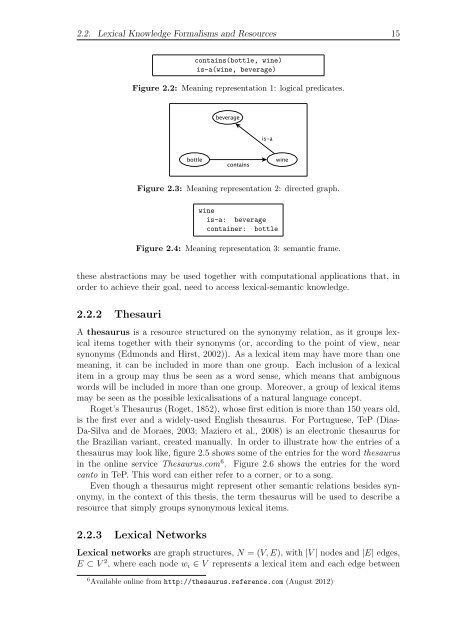Onto.PT: Towards the Automatic Construction of a Lexical Ontology ...
Onto.PT: Towards the Automatic Construction of a Lexical Ontology ...
Onto.PT: Towards the Automatic Construction of a Lexical Ontology ...
You also want an ePaper? Increase the reach of your titles
YUMPU automatically turns print PDFs into web optimized ePapers that Google loves.
2.2. <strong>Lexical</strong> Knowledge Formalisms and Resources 15<br />
contains(bottle, wine)<br />
is-a(wine, beverage)<br />
Figure 2.2: Meaning representation 1: logical predicates.<br />
Figure 2.3: Meaning representation 2: directed graph.<br />
wine<br />
is-a: beverage<br />
container: bottle<br />
Figure 2.4: Meaning representation 3: semantic frame.<br />
<strong>the</strong>se abstractions may be used toge<strong>the</strong>r with computational applications that, in<br />
order to achieve <strong>the</strong>ir goal, need to access lexical-semantic knowledge.<br />
2.2.2 Thesauri<br />
A <strong>the</strong>saurus is a resource structured on <strong>the</strong> synonymy relation, as it groups lexical<br />
items toge<strong>the</strong>r with <strong>the</strong>ir synonyms (or, according to <strong>the</strong> point <strong>of</strong> view, near<br />
synonyms (Edmonds and Hirst, 2002)). As a lexical item may have more than one<br />
meaning, it can be included in more than one group. Each inclusion <strong>of</strong> a lexical<br />
item in a group may thus be seen as a word sense, which means that ambiguous<br />
words will be included in more than one group. Moreover, a group <strong>of</strong> lexical items<br />
may be seen as <strong>the</strong> possible lexicalisations <strong>of</strong> a natural language concept.<br />
Roget’s Thesaurus (Roget, 1852), whose first edition is more than 150 years old,<br />
is <strong>the</strong> first ever and a widely-used English <strong>the</strong>saurus. For Portuguese, TeP (Dias-<br />
Da-Silva and de Moraes, 2003; Maziero et al., 2008) is an electronic <strong>the</strong>saurus for<br />
<strong>the</strong> Brazilian variant, created manually. In order to illustrate how <strong>the</strong> entries <strong>of</strong> a<br />
<strong>the</strong>saurus may look like, figure 2.5 shows some <strong>of</strong> <strong>the</strong> entries for <strong>the</strong> word <strong>the</strong>saurus<br />
in <strong>the</strong> online service Thesaurus.com 6 . Figure 2.6 shows <strong>the</strong> entries for <strong>the</strong> word<br />
canto in TeP. This word can ei<strong>the</strong>r refer to a corner, or to a song.<br />
Even though a <strong>the</strong>saurus might represent o<strong>the</strong>r semantic relations besides synonymy,<br />
in <strong>the</strong> context <strong>of</strong> this <strong>the</strong>sis, <strong>the</strong> term <strong>the</strong>saurus will be used to describe a<br />
resource that simply groups synonymous lexical items.<br />
2.2.3 <strong>Lexical</strong> Networks<br />
<strong>Lexical</strong> networks are graph structures, N = (V, E), with |V | nodes and |E| edges,<br />
E ⊂ V 2 , where each node wi ∈ V represents a lexical item and each edge between<br />
6 Available online from http://<strong>the</strong>saurus.reference.com (August 2012)

















